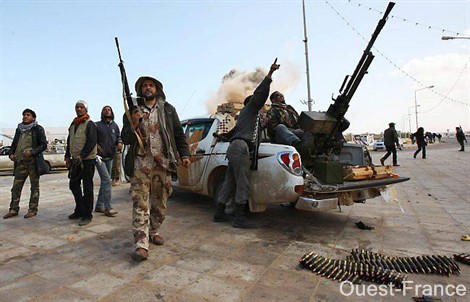The death of Libya

October 20, 2011, Gaddafi was captured alive and then shot dead by members of the rebellion that started in February of the same year. Since then, Libya has descended into chaos. Gaddafi's Libya was obviously not a model of democracy or respect for human rights but the "Revolutionary Guide" has allowed Libya to maintain consistency despite its tribal character and eventful history.
THE END OF THE "SYSTEM Gaddafi" ...
Gaddafi that reads its Green Paper in which he details his vision of democracy & politics Gaddafi had managed to establish a precarious balance in Libya by a mixture of coercion, redistribution of wealth from oil, clientelism but also through agreements and alliances with most of the Libyan tribes. This is what is called the "Covenant of the Green Paper" .
The tribes played an extremely important role in the Gaddafi regime. Indeed, membership in a tribe could help achieve very favorable social positions. Indeed, Gaddafi had managed to set up a social ladder according to the tribe of belonging. Former Libyan head of state was thus able to control the tribal system by developing alliances games and a wealth redistribution network to consolidate its power. Gaddafi had therefore succeeded in establishing an alliance network built around his own person, but not a real state. In addition, Gaddafi has used a highly developed and brutal repressive apparatus. This unit, composed of the armed branches of some tribes, has benefited from significant capital investment from the regime, allowing it to survive for forty-two years of the "reign" of Gaddafi.
However, the gradual erosion of political, authoritarian but redistributor ended the Gaddafi regime. For if in the 1970s and 1980s, progress has benefited the entire Libyan population in terms of infrastructure but also social aid, the following two decades have seen a slow deterioration of the redistribution system. Thus, Gaddafi's Libya was unable to resist changes in oil prices, the near absence of economic take-off at too undiversified economy, embargoes and waste of resources at too ambitious foreign policy. Finally, the 2008 economic crisis and rising raw material prices during the same period have worsened the situation.
All these elements have led a revival of the tribes. In 2008, several tribes battled them already threatening the unity of the Libyan state. But in 2011, with the Tunisian and Egyptian revolts, tribes regained their original function and some of them were opposed to Gaddafi. So there has been a "retribalisation" of Libyan society.
... A GOOD THING OR A BAD? Power struggles in Libya
The result of this revolution does not seem to be really positive for Libya. Since the fall of the Libyan leader, the country was crossed by numerous separatism waves. To the east of the country, Cyrenaica region, a federalist movement had emerged quickly after the end of the revolution. To the west, the Berber tribes claimed the recognition of their identity while in the south of the country, the Tuareg and Toubou have also had separatist tendencies.
A real civil war has settled since the end of the Libyan revolution. Indeed, many of the militias "thuwar" (revolutionaries) have benefited from the institutional vacuum left by the fall of the Gaddafi regime. These "heroes of the Libyan revolution" have therefore taken the place of a missing police and army, and control strategic buildings and districts within major Libyan cities, but also some important oil sites.
Finally, the Libyan government appears to have given way to a struggle between various militias, tribes and two self-proclaimed governments. The first, based in Tobruk in the east, the government said "official" as recognized by the international community, and is supported by the army. The second is not recognized by the international community and is based in Tripoli in the west. It is especially supported by the Islamist militia coalition Fajr Libya.
Ultimately, it is clear that Muammar Gaddafi was a dictator disrespectful of human rights. However, the current situation in Libya leads us to wonder about the effects of Western intervention in 2011 . Indeed, if this was necessary to prevent potential massacres of civilians, it is legitimate to question the merits of the decision to slaughter Gaddafi and neglect the reconstruction of Libyan society after the end of the intervention military. Especially since Europe is the first to be hit by the collapse of the Libyan state which has become a hub for illegal immigration but also of international terrorism.
No comments:
Post a Comment